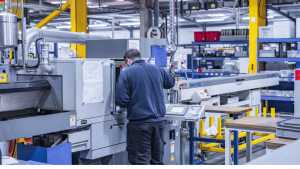Published - 14th Dec 2023
Revolutionising the machining of high-volume parts with tight tolerances
Precision, speed and versatility are crucial in modern machining. Industries from defence and aerospace to medical, oil & gas demand technologies that can consistently deliver intricate components to tight tolerances. The development of sliding head machining has revolutionised this machining landscape.
Sliding head machining, also known as Swiss tooling or Swiss turning, is a highly advanced and versatile machining process. As a leading subcontract machining company, Metaltech Precision has invested heavily in sliding head machining centres, enhancing the ability of this precision machining company to supply high precision, high quality technical components to customers quickly and efficiently.
This article delves into the world of sliding head machining, exploring its history, applications, advantages, and how Metaltech Precision is leading the way in automated production of even the smallest or most intricate parts.

Turning, milling and other types of machining traditionally employ a rotating spindle carrying the workpiece, which does not move on any other axis. Cutting tools are then moved along this ‘fixed head’ by hand or machine to produce the required shape.
The roots of ‘sliding head’ machining can be traced back to the Swiss watchmaking industry in the late 18th century. Swiss watchmakers needed a better way to produce intricate, high-precision components for their timepieces. This led to the development of the first sliding head lathes, where the workpiece itself was moved against a static tool, allowing greater control and precision. These early machines laid the foundation for the evolution of sliding head machining into the advanced technology we see today.
A sliding head lathe has the capability for turning, drilling, milling, boring and more, so these traditional functions can now all be performed by one machine. For this reason, sliding head machines are often referred to as ‘machining centres’.
The sliding head machine works as follows:
Subcontract machining companies such as Metaltech Precision now generally use 3 metre long, round rods of raw material known as ‘barstock’ (or ‘bars’) in a range of diameters to feed their fixed and sliding head machines.
Sliding head machining centres are each capable of machining bars up to a defined diameter (for example, a Citizen L32-12 machine can machine bars up to 32mm diameter), whilst they are also capable of machining much smaller bars to produce mini or micro components.
Manual loading of raw materials quickly became inefficient as these automated machines increased the speed of production. Each sliding head machine in our machine shop is now attached its own loading system to increase efficiency. In many cases this consists of a static bar feeder: a horizontal device which can be loaded with bars. The bars are automatically taken up and inserted into the spindle as required.
For large components, such as those produced on our vertical fixed head machine, a lift and gantry may be used to load and unload. Metaltech Precision has also invested recently in robotic loading systems, enabling high-performance CNC machines to work outside normal working hours.
Technical developments have increased the capabilities of Metaltech Precision’s machining shop. With the development of Computer Numerical Control (CNC), sliding head machines became capable of moving the cutting tools with immense speed and precision, enabling complex geometries and intricate components to be produced with ease.
Improvements in Computer Aided Design (CAD) software, followed by extensive use of Computer Aided Manufacturing (CAM) tools to convert CAD models for input into sliding head machining centres, have increasingly enabled leading precision machine shops such as Metaltech Precision to automate production. Customers benefit from the high quality, fast and consistent machining offered by these automated sliding head machining centres.
In addition to our significant investment in automation and software, we continue to rely upon skilled employees at our extensive machining facility. We have invested in a large team of operatives, setters and programmers to ensure that the machines continue to function and deliver optimally, keeping Metaltech Precision at the forefront of subcontract machining for a wide range of performance-critical components.
Sliding head machines are extremely versatile, capable of machining virtually anything from plastics to most metals and exotics. Specific alloys used in chemically-aggressive environments such as in the oil and gas industries can be machined in this way, as well as alloys such as the titanium used to provide strong but lightweight parts for aerospace and motorsport applications.
Metaltech Precision are also expert in machining difficult raw materials. For example, 25 years’ experience has allowed us to effectively machine Remko, a notoriously soft and tricky to machine soft iron.
At Metaltech Precision we have an ever-growing range of sliding head machining centres, offering significant production capacity to our customers. There are many benefits to manufacturing parts using sliding head machining:
Sophisticated CNC machining must be programmed to function properly, demanding time and expertise. Where small batches can be machined on fixed head machines there may be little gain from using sliding head capability, although it is sometimes cost-effective to use our CNC sliding head capacity to machine low volume but intricate parts.
By contrast, sliding head machining is particularly suited for high volume production runs. Once programmed, a sliding head machining centre with automatic or robotic feeder can quickly produce consistent, high-quality components. This combination of efficiency and precision makes it a competitive choice in high volume machining.
The versatility of sliding head machining makes it suitable for a wide range of applications, including:
In today’s world, the demand for smaller and more compact devices is growing. Metaltech Precision offers micro machining of small components and parts, from 0.5mm diameter. Our highly skilled engineers have many years’ experience in the machining of small and even miniature components with intricate requirements, such as those used in electrical connectors, scientific test equipment and medical devices.
Machining small parts requires excellent precision due to the extremely tight tolerances. The workpiece must be rotated much faster to achieve the optimum cutting speed, and machining tools must be appropriate for the details needed to create small parts. We are expert in micro machining and ensure that your small parts and miniature components are professionally produced, fully finished and tested.
We are proud of our skilled team and extensive machining resources at Metaltech Precision. During the last two years we have significantly extended our plant list at our UK premises in Chard, Somerset, to become one of the largest and most diverse sub-contract machine shops in the Southwest.
“Investing in robotic and automated systems alongside our substantial sliding head machining capacity has helped maintain our reputation as a leading subcontractor for precision machining,” says Managing Director Andy Riste. “We have the capability and expertise to supply precision machined parts fast and in volume. Give us a call!”
For more information on our sliding head machining expertise, contact us on +441460221737 or email [email protected].
If you have a project, talk to our experienced sales team
Contact us


